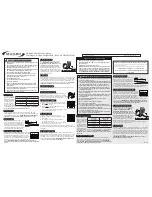
© EPS Stromversorgung in 2022, this information is subject to change without notice
69
30000800_manual_psb_10000_4u_30kw_en_04
3.7
Alarms and monitoring
3.7.1
Definition of terms
There is a clear distinction between device alarms (see
“3.4. Alarm conditions”), such as overvoltage protection
OVP
or
overheating protection
OT
, and user defined events such as
OVD
(overvoltage detection). Whilst device alarms only switch
off the DC terminal, user defined events can do more. They can also switch off the DC terminal(
Action
=
Alarm
), but can al-
ternatively simply give an acoustic signal to make the user aware. The actions driven by
user defined events
can be selected:
Action
Impact
Example
None
User defined event is disabled.
Signal
On reaching the condition which triggers the event, the action
Signal
will
show a text message in the status area of the display.
Warning
On reaching the condition which triggers the event, the action
Warning
will
show a text message in the status area of the display and pop up an additional
warning message which can be noticed from a bigger distance.
Alarm
On reaching the condition which triggers the event, the action
Alarm
will show
a text message in the status area of the display with an additional alarm pop-
up, and additionally emit an acoustic signal (if activated). Furthermore the DC
terminal is switched off. Most of the device alarms are signaled on the analog
interface, while all can be queried via the digital interfaces.
3.7.2
Device alarm and event handling
Important to know:
When switching the DC input (sink mode) of the device off while a current limited source still supplies
energy, the output voltage of the source can rise immediately and due to transient times the output
voltage can have an overshoot to an unknown level which might trigger the overvoltage alarm (OVP)
or the overvoltage supervision event (OVD) of the PSB 10000 in case these thresholds are adjusted to
sensitive levels.
A device alarm incident will usually lead to DC terminal switch-off, the appearance of a pop-up in the middle of the display
and, if activated, an acoustic signal to make the user aware. An alarm must always be acknowledged.
►
How to acknowledge an alarm in the display (during manual control)
1.
If the alarm is indicated as a pop-up, tap
Acknowledge
.
2.
If the alarm has already been acknowledged, but is still displayed in the status area, then
first tap the status area to display the pop-up and then
Acknowledge
.
In order to acknowledge an alarm during analog remote control refer to
“3.6.4.2. Acknowledging device alarms”. To acknowl-
edge in digital remote control, refer to the external documentation “Programming Guide ModBus & SCPI”.
Some device alarms are configurable, separately for source and sink mode:
Short
Long
Description
Range
Indication
OVP
O
ver
V
oltage
P
rotection
Triggers an alarm as soon as the voltage on the DC termi-
nal reaches the defined threshold. The DC terminal will be
switched off.
0 V...1.1*U
Nom
Display, analog &
digital interfaces
OCP
O
ver
C
urrent
P
rotection
Triggers an alarm as soon as the current in the DC termi-
nal reaches the defined threshold. The DC terminal will be
switched off.
0 A...1.1*I
Nom
Display, analog &
digital interfaces
OPP
O
ver
P
ower
P
rotection
Triggers an alarm as soon as the output or input pow-
er reaches the defined threshold. The DC terminal will be
switched off.
0 W...1.1*P
Nom
Display, analog &
digital interfaces
















































